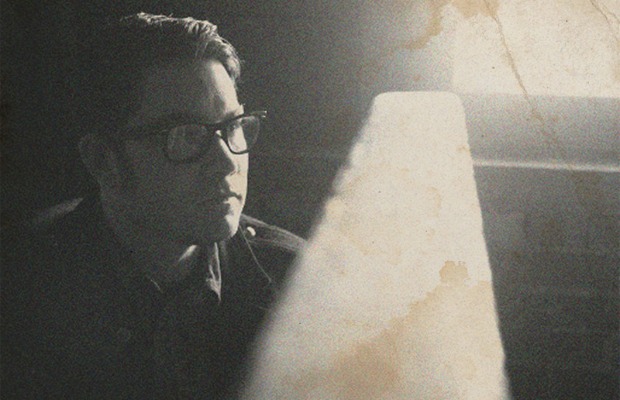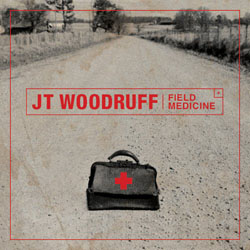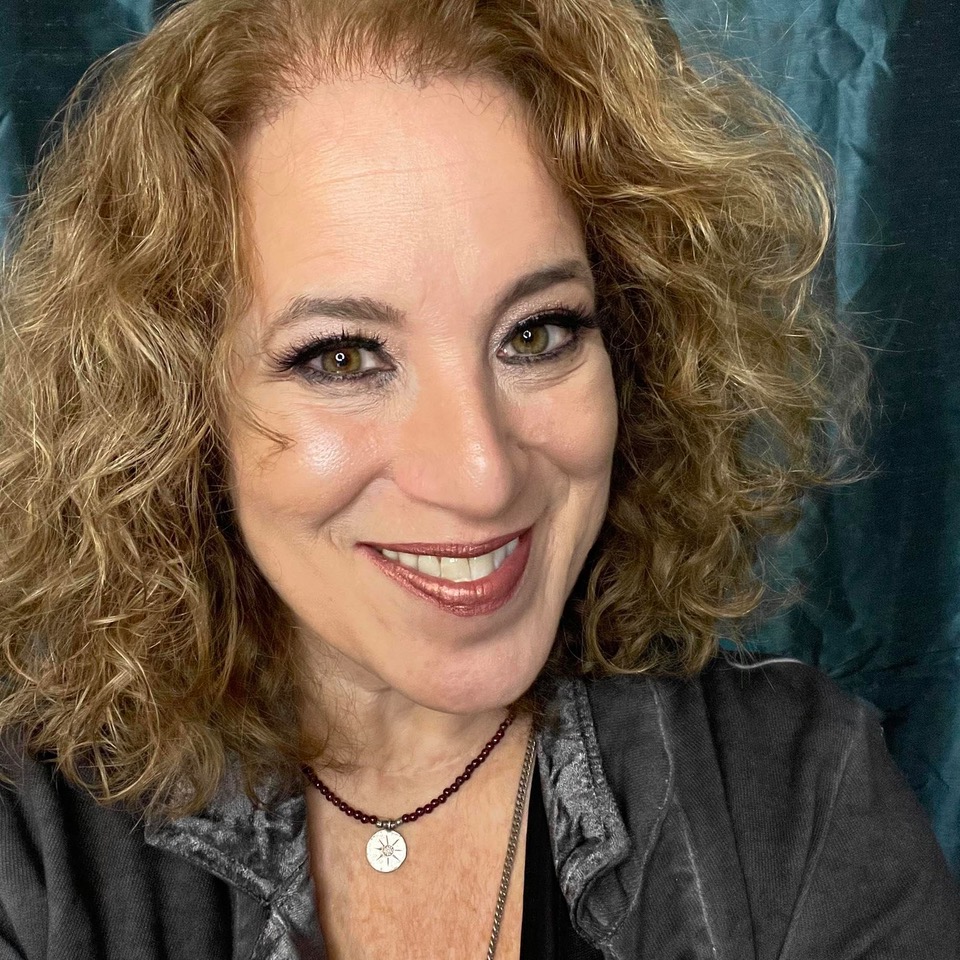Interview: Hawthorne Heights’ JT Woodruff Gives Us a Dose of ‘Field Medicine’

If you’re a fan of Hawthorne Heights, I’ll bet you’ll meander on over to check out lead singer and rhythm guitarist JT Woodruff’s latest solo release, Field Medicine.
But if you’re not an HH fan, well that’s where the real fun begins.
This collection of haunting, stark meanderings is so fabulously bleak and somewhat twisted, with touches of pure beauty.
Favorites include the wonderfully titled, “Lost in a Swell,” with its sense of misshapen hope. And the slightly off-balance “The Hundreds” with it’s lilting acoustic guitar accompaniment, and its lovely but sorrowful statement, “Sometimes…I just don’t feel right.” It’s a glimpse into Woodruff’s somewhat askew sensibility.
Even Woodruff’s album closeout of a cover of Tom Petty’s “Walls” is surprisingly refreshing, with its jangly solo guitar strum and some light, floating vocal harmonies.
Here we sat down with him to get a glimpse into his mad genius…
Why did you go in the solo direction? Was it because there are songs you’ve been writing along the way that maybe didn’t fit with the band?
All the latest guitar news, interviews, lessons, reviews, deals and more, direct to your inbox!
I’ve been doing solo stuff for a couple years now. You’re right, it is a way to do something that is a little bit different, that I know won’t fit with Hawthorne Heights. I don’t want to try to force slower, acoustic-type songs into what we’re doing. One per album is kind of cool but I don’t want to write one acoustic song every three years.
It’s a lot of fun. It’s a good release for me to be able to get out every once in a while. Everything’s just stripped back, it’s just me and a guitar, and just a couple of chords, and a melody. It can just be really cool to do things like that. I listen to a lot of different types of music. It’s fun to do a little something different.
Do you have some more acoustic-based influences?
Yeah, definitely. My three favorite songwriters are Bruce Springsteen, Tom Petty, and Bob Dylan.
Ah! I was going to ask you why you chose that Petty song to close out the album, but now I know.
Yeah, yeah. He’s always been a big influence. Bruce Springsteen was always blaring through my house as a kid, so I kind of grew up with the Born in the U.S.A. album. A little bit later on, I started to dig into everything else he had done and just kind of fell in love with it. But that’s not really what influenced Hawthorne Heights, but it has always influenced me as a songwriter on how simple things can be. If the theme of it is complex, it doesn’t need to be a complex song.
Right. I get this feeling, listening to the album, that there are these very simple arrangements, and some of them are even pretty, but the subject matter still seems to have this feeling of desperation or that it’s maybe a little twisted in some way.
Welcome to the Midwest.
It’s not typical, which is good.

Well, thank you. I try not to be typical in most things I do.
I think my favorite song is “Locked in a Swell,” which just even that phrase makes me wonder, “Where did that come from?”
I actually wrote that song while on a pier in Australia. We hadn’t been back there in a long time and I was just sitting. My absolute favorite place to be is the ocean. I think that’s because I’m from the Midwest. It just looks beautiful staring at it when I’m used to staring at flat land and cornfields. I just can sit there and stare all day.
But we were sitting up at this beautiful viewing area. I had my little pad and paper and was sketching out the lyrics. It just reminded me of how being able to travel a bunch, there’s just beautiful places where you never would really expect them. It’s kind of about me being trapped in a bottle and just floating along the sea and seeing every place I can see.
Yeah. I love everything about the song. Even the structure of how you bring the bridge back in twice. It’s cool.
Thank you very much. I tried to make it a little bit different.
Tell me a little bit about the writing process for the album. Was it different than with the band? Do you typically start with a lyric or did you mix it up?
Yeah, that’s a good question. As a band, we all write together, and we all write separately. Every album is going to have elements of each one of us as a songwriter. It’s not the type of band that’s just kind of me showing them songs and they do them. We’re a very collaborative band.
When it’s just me and a guitar, I really just sit there with a pad and paper, a cup of coffee, and an acoustic guitar. I just sit there and I kind of write it all at once, whether it starts with a line or it starts with a chord, or something like that. I typically write even all the melodies and everything, all at once to try to incorporate the whole song together. I just keep at it and just keep at it until the song is done. I try not to move on too quickly.
Check out the video for the title track, "Field Medicine" here:
What was your recording process like for the album? Who did you have come in and record with you?
The recording process was very easy and laid back for me because our guitar player, Micah, owns a studio in the town and he and I live in. So, about five blocks away from where we live, I can walk to the studio anytime I want. Anytime he could fit me in, we would be in there tracking.
He’s always been the guy that I’ve known the longest, the guy that I’ve worked with the longest so he and I are really in tune with what each other can do musically. Anything that I’m bad at, any intricate things, that’s his strong point, so that’s why we’ve always worked really well together in Hawthorne Heights.
I’m great coming up with chords and arrangements for my specific vocal and he’s great making them not sound like they’re chords, which is cool. He came up with a lot of the cool dreamy-sounding lead lines, a lot of piano stuff. He did a really good job with it but it was really – he’s very easy to record with. He’s very patient. If I want to sit there and try something and try something, he’s very good about experimenting and trying to take my brain where it’s trying to go and not knowing how to get there.
Tell me about some of the acoustic gear that you used on the album.
My main guitar is a Taylor. It’s a GS8. That’s like the main thing that I use when I play live and when I track. I also use a Gibson J45 a whole bunch. That’s another one of my go-tos. That would be about it for rhythm stuff. We had one, a Gibson Jumbo as well, and one of the Taylors with the crazy koa wood that sounded really great.
If I was doing a lead or something like that, I have this weird Martin Alternative X guitar that they only made for one year. It’s an aluminum body, it sounds really, really cool for lead-type stuff. I try to use as much acoustic as I can in the arrangements and even some of the distorted guitars that you hear are acoustic as well, like that Alternative X. Anything electric is just going to be a Telecaster, for the most part.
When you did some of those interesting, distorted guitars what did you plug them into to get that sound?
We have a really cool cigar box amp that I use a lot of stuff like that. It’s a little tiny boutique amp made by this company in Wheeling, West Virginia. It’s called Saner. Anything you plug into it just immediately turns to the 1800s, which is just awesome. It’s literally made out of a cigar box. So a lot of that and a decent amount of plugging it into a Tube Screamer and just kind of manipulating the knobs to make it sound odd. I wanted a lot of things to sound like being played in a Prohibition era nightclub, stuff like that.
What’s your live setup like? You use an acoustic-electric, right?
Yeah. I always like to do that because you really, you’re at the mercy of the sound guy. And you really have no idea if he’s like super into his job or absolutely hates his job.
I’m not as worried about what people can hear out there. I’m worried that I can perform myself, ‘cause if I feel good about my set, I assume everybody else does, too. It’s a blessing and a curse. When I start to sing loud, it is the loudest, most piercing freight train of a sound. And if I can’t hear my guitar, I can blow everything else out. So I like to plug in an acoustic and electric just to cover my bets.
Yeah, good idea. The monitoring is definitely a different situation solo than playing with the band, so you have to find that right balance of sounds.
Yep, I like putting my monitor and the band is the sample track, which will have a keyboard or something we don’t want to play live and my lead vocal, and that’s it. So that’s very easy. I can hear everything else. Everything else is just so freaking loud. You would think it would be very easy because it’s just a guitar and just a vocal. But man, if you can’t hear one or the other, you’re off.
No, it’s true. I think fans don’t realize how much the monitoring situation effects the performance.
Oh yeah, definitely. Specifically in an acoustic show, because everybody’s talking the whole time, and they don’t even realize they are.
Find out more at www.facebook.com/jtwoodruffmusic
www.twitter.com/jthawthorne
www.fieldmedicine.net
Laura B. Whitmore is a music industry marketing veteran, music journalist and editor, writing for Parade.com, Guitar World, and others. She has interviewed hundreds of musicians and hosts the She Rocks Podcast. As the founder of the Women’s International Music Network, she advocates for women in the music industry and produces the annual She Rocks Awards. She is the Senior Vice President of Marketing for Positive Grid, making the world safe for guitar exploration everywhere! A guitarist and singer/songwriter, Laura is currently co-writing an album of pop songs that empower and energize girls.

